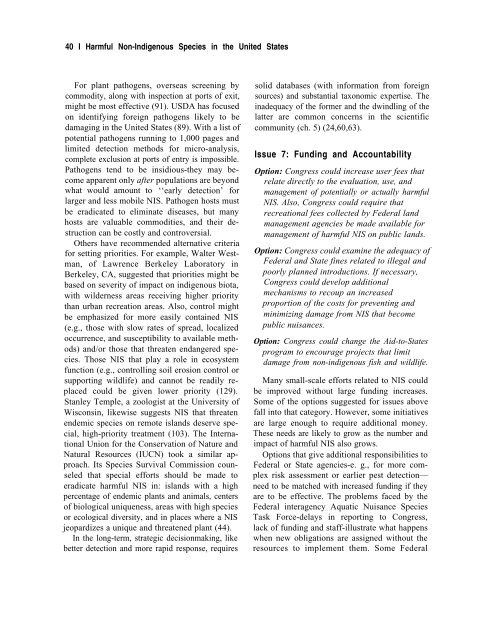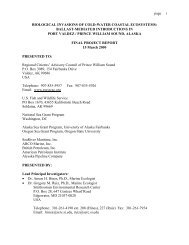Harmful Non-Indigenous Species in the United States - Aquatic ...
Harmful Non-Indigenous Species in the United States - Aquatic ...
Harmful Non-Indigenous Species in the United States - Aquatic ...
You also want an ePaper? Increase the reach of your titles
YUMPU automatically turns print PDFs into web optimized ePapers that Google loves.
40 I <strong>Harmful</strong> <strong>Non</strong>-<strong>Indigenous</strong> <strong>Species</strong> <strong>in</strong> <strong>the</strong> <strong>United</strong> <strong>States</strong>For plant pathogens, overseas screen<strong>in</strong>g bycommodity, along with <strong>in</strong>spection at ports of exit,might be most effective (91). USDA has focusedon identify<strong>in</strong>g foreign pathogens likely to bedamag<strong>in</strong>g <strong>in</strong> <strong>the</strong> <strong>United</strong> <strong>States</strong> (89). With a list ofpotential pathogens runn<strong>in</strong>g to 1,000 pages andlimited detection methods for micro-analysis,complete exclusion at ports of entry is impossible.Pathogens tend to be <strong>in</strong>sidious-<strong>the</strong>y may becomeapparent only after populations are beyondwhat would amount to ‘‘early detection’ forlarger and less mobile NIS. Pathogen hosts mustbe eradicated to elim<strong>in</strong>ate diseases, but manyhosts are valuable commodities, and <strong>the</strong>ir destructioncan be costly and controversial.O<strong>the</strong>rs have recommended alternative criteriafor sett<strong>in</strong>g priorities. For example, Walter Westman,of Lawrence Berkeley Laboratory <strong>in</strong>Berkeley, CA, suggested that priorities might bebased on severity of impact on <strong>in</strong>digenous biota,with wilderness areas receiv<strong>in</strong>g higher prioritythan urban recreation areas. Also, control mightbe emphasized for more easily conta<strong>in</strong>ed NIS(e.g., those with slow rates of spread, localizedoccurrence, and susceptibility to available methods)and/or those that threaten endangered species.Those NIS that play a role <strong>in</strong> ecosystemfunction (e.g., controll<strong>in</strong>g soil erosion control orsupport<strong>in</strong>g wildlife) and cannot be readily replacedcould be given lower priority (129).Stanley Temple, a zoologist at <strong>the</strong> University ofWiscons<strong>in</strong>, likewise suggests NIS that threatenendemic species on remote islands deserve special,high-priority treatment (103). The InternationalUnion for <strong>the</strong> Conservation of Nature andNatural Resources (IUCN) took a similar approach.Its <strong>Species</strong> Survival Commission counseledthat special efforts should be made toeradicate harmful NIS <strong>in</strong>: islands with a highpercentage of endemic plants and animals, centersof biological uniqueness, areas with high speciesor ecological diversity, and <strong>in</strong> places where a NISjeopardizes a unique and threatened plant (44).In <strong>the</strong> long-term, strategic decisionmak<strong>in</strong>g, likebetter detection and more rapid response, requiressolid databases (with <strong>in</strong>formation from foreignsources) and substantial taxonomic expertise. The<strong>in</strong>adequacy of <strong>the</strong> former and <strong>the</strong> dw<strong>in</strong>dl<strong>in</strong>g of <strong>the</strong>latter are common concerns <strong>in</strong> <strong>the</strong> scientificcommunity (ch. 5) (24,60,63).Issue 7: Fund<strong>in</strong>g and AccountabilityOption: Congress could <strong>in</strong>crease user fees thatrelate directly to <strong>the</strong> evaluation, use, andmanagement of potentially or actually harmfulNIS. Also, Congress could require thatrecreational fees collected by Federal landmanagement agencies be made available formanagement of harmful NIS on public lands.Option: Congress could exam<strong>in</strong>e <strong>the</strong> adequacy ofFederal and State f<strong>in</strong>es related to illegal andpoorly planned <strong>in</strong>troductions. If necessary,Congress could develop additionalmechanisms to recoup an <strong>in</strong>creasedproportion of <strong>the</strong> costs for prevent<strong>in</strong>g andm<strong>in</strong>imiz<strong>in</strong>g damage from NIS that becomepublic nuisances.Option: Congress could change <strong>the</strong> Aid-to-<strong>States</strong>program to encourage projects that limitdamage from non-<strong>in</strong>digenous fish and wildlife.Many small-scale efforts related to NIS couldbe improved without large fund<strong>in</strong>g <strong>in</strong>creases.Some of <strong>the</strong> options suggested for issues abovefall <strong>in</strong>to that category. However, some <strong>in</strong>itiativesare large enough to require additional money.These needs are likely to grow as <strong>the</strong> number andimpact of harmful NIS also grows.Options that give additional responsibilities toFederal or State agencies-e. g., for more complexrisk assessment or earlier pest detection—need to be matched with <strong>in</strong>creased fund<strong>in</strong>g if <strong>the</strong>yare to be effective. The problems faced by <strong>the</strong>Federal <strong>in</strong>teragency <strong>Aquatic</strong> Nuisance <strong>Species</strong>Task Force-delays <strong>in</strong> report<strong>in</strong>g to Congress,lack of fund<strong>in</strong>g and staff-illustrate what happenswhen new obligations are assigned without <strong>the</strong>resources to implement <strong>the</strong>m. Some Federal














